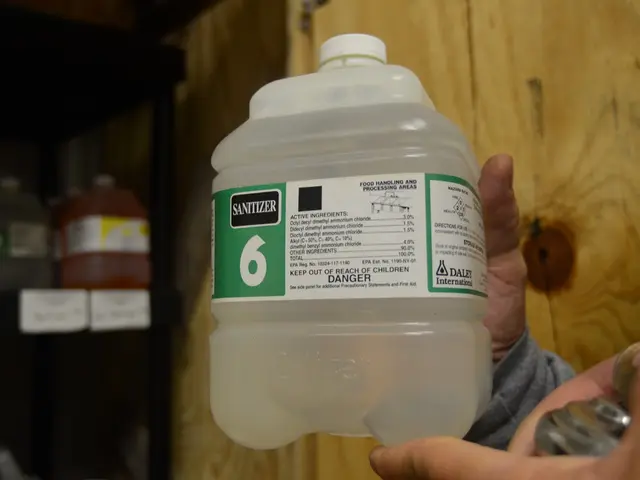Differentiating between Roseola and measles rashes: Understanding the distinct attributes.
In the realm of childhood illnesses, two viral infections, Roseola and Measles, share some striking similarities. However, understanding their distinguishing features can be crucial for proper diagnosis, treatment, and prevention.
Roseola, also known as roseola infantum, sixth disease, or exanthema subitum, is a viral infection that primarily affects infants between the ages of 6 months to 2 years. In contrast, Measles usually targets older infants and children.
One of the most significant differences lies in the symptoms that precede the rash. Roseola is characterized by a high fever that lasts for 3-5 days, which abruptly resolves just before the rash appears. On the other hand, Measles presents with high fever, often exceeding 40°C, accompanied by cough, conjunctivitis (red eyes), and Koplik spots inside the mouth.
The rash patterns also differ. In Roseola, the rash starts on the trunk and then spreads to limbs, while in Measles, the rash begins on the face and spreads downward in a cephalocaudal pattern. The rash in Roseola is maculopapular, often resembling Measles, but without catarrhal (respiratory) symptoms. The Measles rash becomes confluent, merging together, while the Roseola rash is usually not confluent.
Roseola is less contagious in the rash phase, primarily caused by human herpesvirus 6 (HHV-6) or human herpesvirus 7 (HHV-7). Measles, however, is highly contagious from 4 days before to 4 days after rash onset, making it a more significant public health concern.
Both illnesses share some common symptoms, such as high fever, conjunctivitis, and rash. However, the presence of Koplik spots in the mouth, conjunctivitis, and cough are more common in Measles. Roseola, on the other hand, does not typically present with Koplik spots or significant respiratory symptoms.
Neither Roseola nor Measles have specific treatments. Doctors usually recommend rest, fluids, painkillers, and anti-inflammatories to control the fever. In cases of malnutrition or immunocompromised individuals, Vitamin A is recommended for those with Measles.
Prevention is key, particularly for Measles, which is a preventable disease with a safe, inexpensive, and effective vaccine. It is essential to seek medical attention if symptoms of either illness appear, and emergency medical care is necessary if a child has a febrile seizure.
In conclusion, understanding the differences between Roseola and Measles can aid in accurate diagnosis and appropriate treatment. Roseola is characterized by a high fever followed by a sudden rash starting on the trunk, while Measles features a rash starting on the face, spreading downward, accompanied by cough, conjunctivitis, and Koplik spots.
In the realm of health-and-wellness, scientific research is essential to understanding and addressing medical-conditions like Roseola and Measles. Although both share similarities, their distinguishing features are crucial for proper diagnosis and treatment.
Roseola, commonly known as roseola infantum, is a viral infection prevalent among infants aged 6 months to 2 years, while Measles primarily affects older infants and children.
One key difference is the presence of symptoms before the rash. Roseola is characterized by a high fever lasting 3-5 days, which resolves prior to the rash, unlike Measles, which is often accompanied by cough, conjunctivitis, and Koplik spots.
The rash patterns also differ: In Roseola, the rash starts on the trunk and spreads to limbs, while in Measles, it begins on the face and moves downward in a cephalocaudal pattern. Roseola's rash is maculopapular and generally not confluent, unlike Measles, where the rash merges together.
Roseola's contagiousness is less pronounced in the rash phase due to human herpesvirus 6 (HHV-6) or human herpesvirus 7 (HHV-7). Measles, however, is highly contagious and requires immediate attention due to its public health implications.
While both illnesses show common symptoms such as high fever and rash, Measles is more prone to exhibiting Koplik spots in the mouth and significant respiratory symptoms. Roseola, in contrast, is less likely to present with Koplik spots or substantial respiratory symptoms.
Neither Roseola nor Measles have specific treatments. Prescription medicines like painkillers and anti-inflammatories are usually recommended to control the fever. Additionally, in cases of malnutrition or immunocompromised individuals with Measles, Vitamin A supplements may be provided.
Preventive measures are highly important, particularly for Measles, which can be prevented with a safe, inexpensive, and effective vaccine. It's crucial to seek medical attention promptly if symptoms of either illness emerge, and emergency care is necessary if a child experiences a febrile seizure.
In the realm of mental-health, it's essential to recognize and manage the stress and anxiety that may stem from dealing with these health issues. Skin-care routines can also help soothe symptoms such as rashes associated with certain medical-conditions.
In the case of chronic conditions like atopic dermatitis or spondylitis, companies like Pfizer are working on developing predictive models and advanced treatment options. Furthermore, businesses like CBD product manufacturers are exploring the potential benefits of CBD in managing symptoms related to conditions such as ulcerative colitis, diabetes, hepatitis, or even mental-health conditions.
In conclusion, understanding the differences between Roseola and Measles can lead to accurate diagnoses and appropriate treatment. Roseola is defined by a fever followed by a sudden rash on the trunk, whereas Measles features a rash starting on the face and moving downward, accompanied by Koplik spots, cough, and conjunctivitis.








